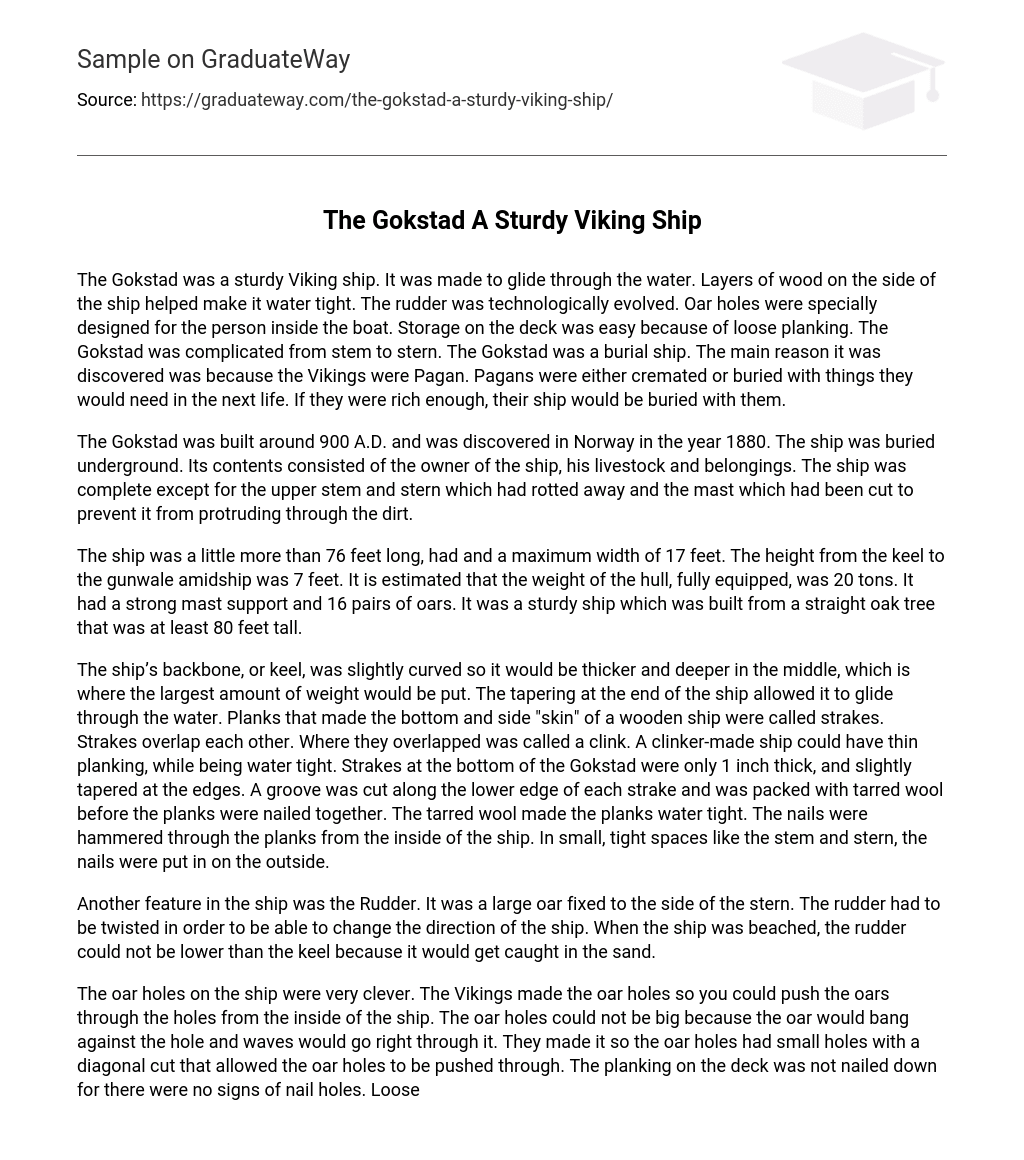The Gokstad was a well-built Viking ship that was designed to navigate efficiently in water. It had strong wooden layers on its sides, which made it durable and watertight. The rudder showcased advanced technology, and the oar holes were specifically designed for the people inside the ship. The deck had loose planking for easy storage. Overall, the Gokstad was a complex ship. It served as a burial vessel because of the Vikings’ adherence to Paganism, where individuals were either cremated or buried with provisions for their afterlife. Wealthy individuals would even have their ships buried alongside them.
The Gokstad, found in Norway in 1880, was constructed in approximately 900 A.D. Buried underground, the ship contained its owner, along with his livestock and possessions. Although the upper stem and stern had decayed and the mast was cut, the ship remained intact.
The ship had a length of over 76 feet, a maximum width of 17 feet, and a height of 7 feet from keel to gunwale amidship. It weighed approximately 20 tons when fully equipped. The ship featured a robust mast support and was equipped with 16 pairs of oars. Constructed from a straight oak tree that measured at least 80 feet in height, this sturdy vessel stood strong.
The keel of the ship had a slight curve to ensure it was thicker and deeper in the middle, where the majority of weight would be placed. The ship’s design also included tapering at the end to facilitate smooth passage through the water. The strakes, which comprised the bottom and sides of the wooden ship, were overlapping planks that formed its “skin”. These overlapping sections were known as clinks. Despite having thin planking, clinker-made ships were able to remain watertight. The bottom strakes of the Gokstad ship were only 1 inch thick with slightly tapered edges. To ensure water tightness, a groove was cut along the lower edge of each strake and filled with tarred wool before securing the planks together with nails. These nails were hammered from the inside of the ship, except in confined areas like the stem and stern, where they were inserted from the outside.
Another feature of the ship was the Rudder, a large oar affixed to the stern side. In order to modify the ship’s direction, the rudder required twisting. However, when the ship was beached, the rudder could not be lowered beneath the keel to avoid getting entangled in the sand.
The clever construction of the oar holes on the ship was notable. The Vikings designed the oar holes to allow for the insertion of oars from inside the ship. To prevent interference and waves from entering, the oar holes were made small, with diagonal cuts for easy insertion. Interestingly, there were no signs of nail holes in the loose planking on the deck. This allowed for convenient storage of cargo beneath the deck, although heavy items couldn’t be carried. Each rowing position under the deck provided storage space for the individual’s weapons. Additionally, there was a rack along the gunwale where shields could be placed. These shields served both as a colorful display and a deterrent for potential attackers. However, if used on the Gokstad, the rack would cover up the oar holes, and there was a risk of the shields being torn off by waves while sailing. This suggests that it was likely used only in shallow waters.
When the wind filled the large sail of The Gokstad, it put a lot of strain on the mast, stays, and hull. To support the mast, which holds the sail, a strong element was needed. This role was fulfilled by the kerling, a heavy block of oak measuring 12 feet 4 inches in length and 2 feet in width. At its top, there was a hole that prevented the mast from leaning too far in any direction. The main purpose of the kerling was to serve as a base for the mast fish, which was the largest single piece of wood on the Gokstad. Named after its shape, the mast fish measured 16 feet 6 inches in length, 3 feet 3 inches in width, and 20 inches in thickness. It rested on four cross beams and received additional support from the kerling. Moreover, it featured an open slit at the top through which the mast could be inserted.
The Gokstad, a clear display of the Vikings’ ingenuity, was a beautifully designed and highly complex vessel that unequivocally demonstrated their mastery of the sea.
The gunwale is the upper edge of the side of a ship or boat.The keel, which runs along the ship’s center line from front to back, is the main structural element of a ship. It acts as the connecting point for the ship’s frames.The mast is a vertical spar that supports the sails and rigging of a sailing vessel.
The stem is the forward part of a ship’s hull.
Stern refers to the rear part of a ship or boat.
The rudder is a plate located at the back of a ship that is used for steering. Bibliography:





